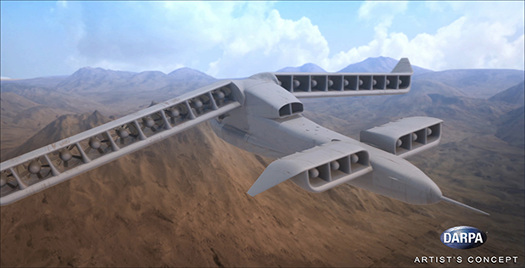 |
| September 20, 2016 | Volume 12 Issue 35 |
Designfax weekly eMagazine
Archives
Partners
Manufacturing Center
Product Spotlight
Modern Applications News
Metalworking Ideas For
Today's Job Shops
Tooling and Production
Strategies for large
metalworking plants
Wings:
Military electric UAV design is plane + copter

An unorthodox unmanned aircraft under development by the Defense Advanced Research Projects Agency (DARPA) would push the limits of technology to combine plane-like speed and helicopter-like agility into one breakthrough vehicle called the Vertical Takeoff and Landing Experimental Plane (VTOL X-Plane). [Image: DARPA]
For decades, aircraft designers seeking to improve vertical takeoff and landing (VTOL) capabilities have endured a substantial set of interrelated challenges. Dozens of attempts have been made to increase top speed without sacrificing range, efficiency, or the ability to do useful work, with each effort struggling or failing in one way or another.
DARPA's VTOL Experimental Plane (VTOL X-Plane) program aims to overcome these challenges through innovative cross-pollination between fixed-wing and rotary-wing technologies and by developing and integrating novel subsystems to enable radical improvements in vertical and cruising flight capabilities. In an important step toward that goal, DARPA awarded the Phase 2 contract for the VTOL X-Plane to Aurora Flight Sciences in March.
"Just when we thought it had all been done before, the Aurora team found room for invention -- truly new elements of engineering and technology that show enormous promise for demonstration on actual flight vehicles," says Ashish Bagai, DARPA program manager.
The Aurora team's design for its unmanned aircraft, named LightningStrike, seeks to provide an approximately 50 percent increase in speed over existing VTOL aircraft designed for comparable mission applications.
"This is an extremely novel approach," Bagai says of the selected design. "It will be very challenging to demonstrate, but it has the potential to move the technology needle the farthest and provide some of the greatest spinoff opportunities for other vertical flight and aviation products."
The VTOL X-Plane program seeks to develop a technology demonstrator that could:
- Achieve a top sustained flight speed of 300 kt to 400 kt.
- Raise aircraft hover efficiency from 60 percent to at least 75 percent.
- Present a more favorable cruise lift-to-drag ratio of at least 10, up from 5 to 6.
- Carry a useful load of at least 40 percent of the vehicle's projected gross weight of 10,000 lb to 12,000 lb.
Aurora's Phase 2 design for VTOL X-Plane, which would be about the size of a Bell Super Huey helicopter, envisions an unmanned aircraft with two large rear wings and two smaller front canards (short winglets mounted near the nose of the aircraft). A Rolls-Royce AE 1107C turboshaft engine -- one used in V-22 Osprey tiltrotor aircraft -- mounted in the fuselage would provide 3 MW (4,000 hp) of electrical power, the equivalent of an average commercial wind turbine. The engine would drive 24 ducted fans, nine integrated into each wing and three inside each canard. Both the wings and the canards would rotate to direct fan thrust as needed: rearward for forward flight, downward for hovering, and at angles during transition between the two.
The design envisions an aircraft that could fly fast and far, hover when needed, and accomplish diverse missions without the need for prepared landing areas. While the technology demonstrator would be unmanned, the technologies that VTOL X-Plane intends to develop could apply equally well to manned aircraft. The program has the goal of performing flight tests in the 2018 timeframe.
VIDEO:The DARPA Vertical Take-Off/Landing X-plane (VTOL x-plane) Program achieved a critical milestone in April 2016 when an Aurora Flight Sciences' subscale (20 percent) vehicle demonstrator successfully flew at a U.S. military facility. The flight met an important DARPA risk-reduction requirement, focusing on validation of the aerodynamic design and flight control system.
Aurora's unique design is only possible through advances in technology over the past 60 years in fields such as air-vehicle and aeromechanics design and testing, adaptive and reconfigurable control systems, and highly integrated designs. It would also be impossible with the classic mechanical drive systems used in today's vertical lift aircraft, Bagai says.
The Phase 2 design uses innovative ways to address many long-standing technical obstacles, the biggest of which is that the design characteristics that enable good hovering capabilities are completely different from those that enable fast forward flight. Among the revolutionary design advances to be incorporated in the technology demonstrator:
- Electric power generation and distribution systems to enable multiple fans and transmission-agnostic air-vehicle designs.
- Modularized, cellular aerodynamic wing design with integrated propulsion to enable the wings to perform efficiently in forward flight, hover, and when transitioning between them.
- Overactuated flight control systems that could change the thrust of each fan to increase maneuverability and efficiency.
"This VTOL X-plane won't be in volume production in the next few years, but is important for the future capabilities it could enable," Bagai says. "Imagine electric aircraft that are more quiet, fuel-efficient, and adaptable and are capable of runway-independent operations. We want to open up whole new design and mission spaces freed from prior constraints, and enable new VTOL aircraft systems and subsystems."
Source: DARPA
Published September 2016
Rate this article
View our terms of use and privacy policy
